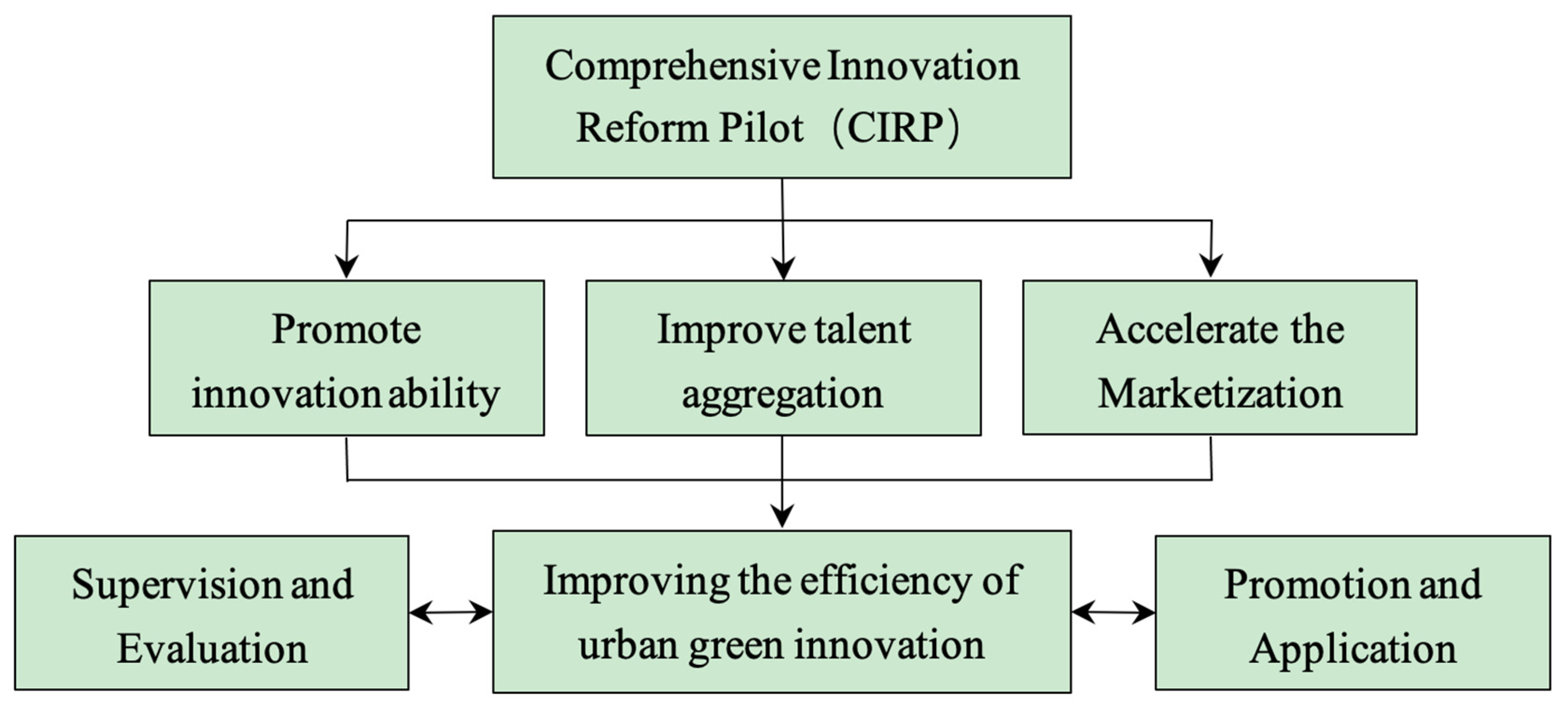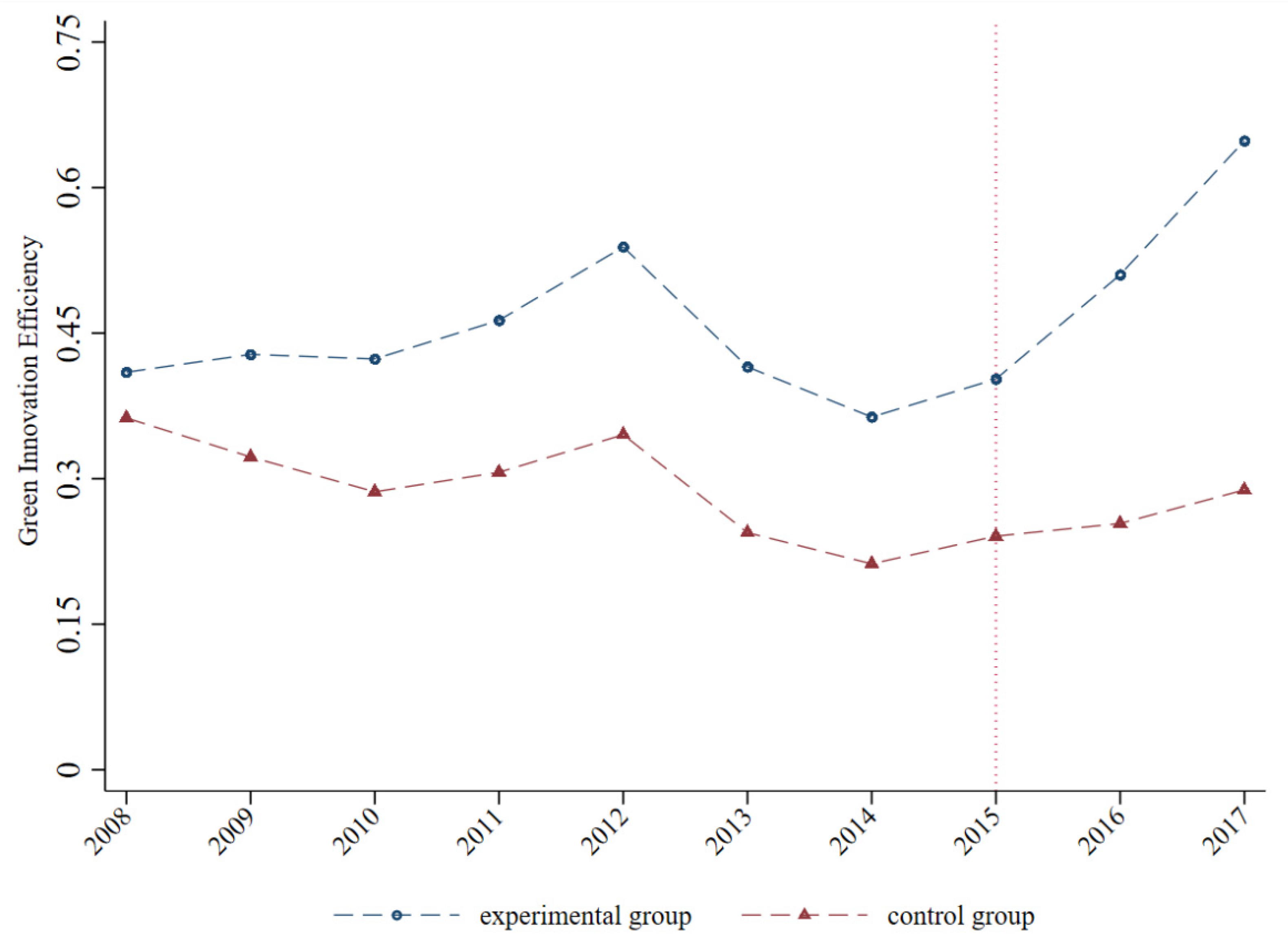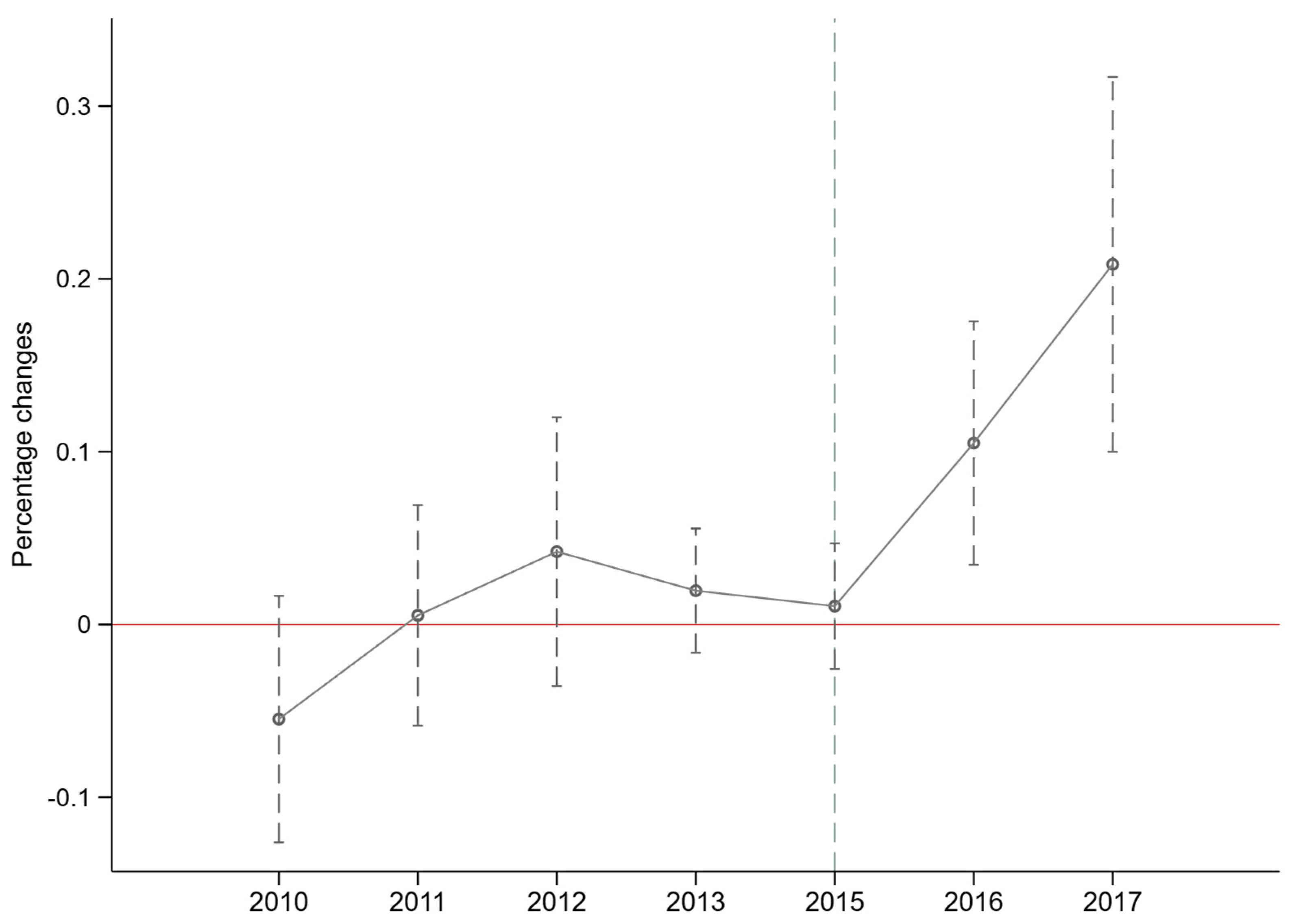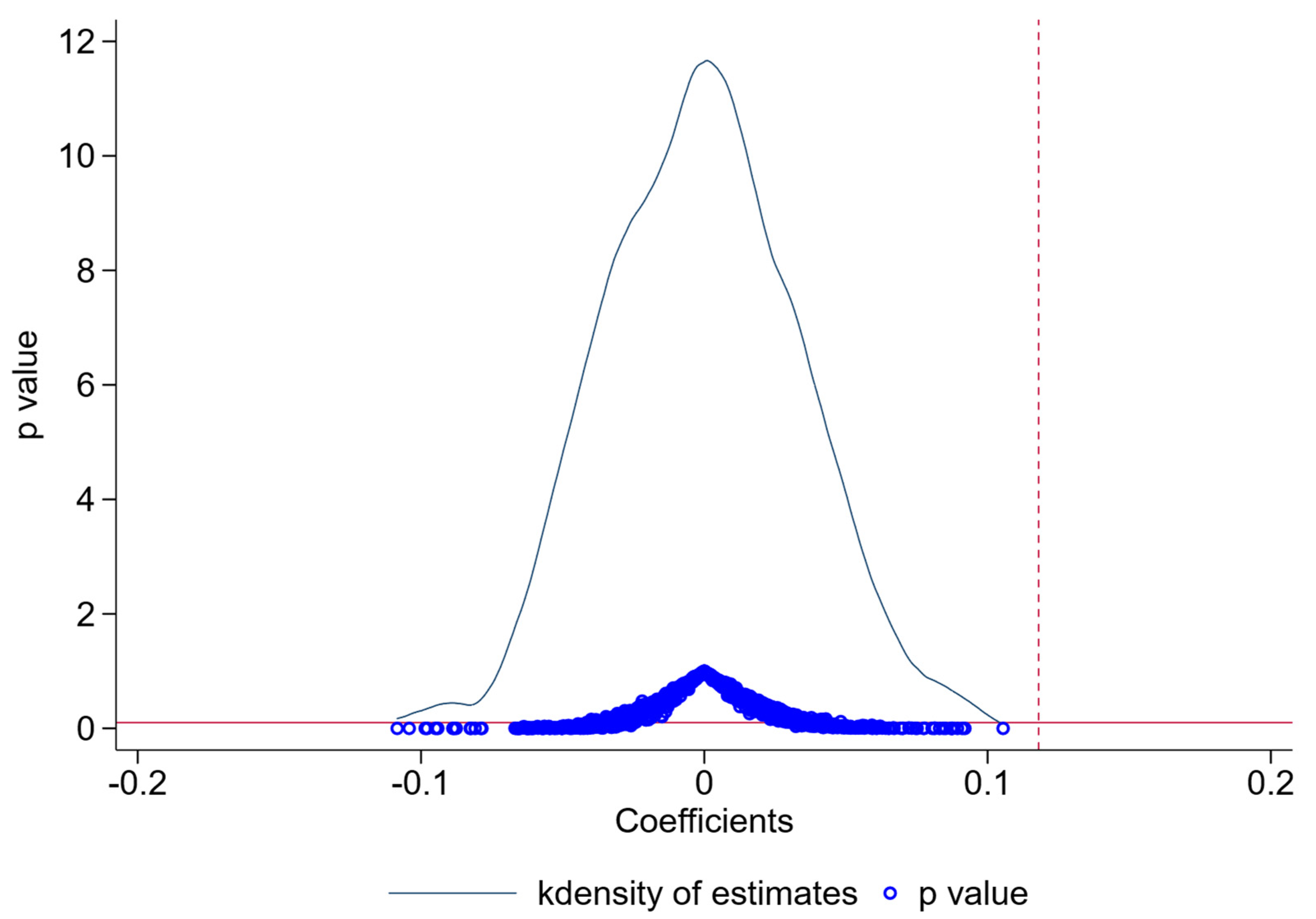1. Introduction
Achieving sustainable growth by decoupling economic growth from environmental pollution is a common goal pursued by many countries in the world [
1]. Innovation is the driving force for development. Similarly, green innovation is the driving force for sustainable growth [
2]. Previous studies have documented that economic growth becomes more sustainable due to green innovation [
3,
4]. Green innovation has a positive impact on productivity in the medium to long term and has become a key catalyst for sustainable development [
5].
Many countries are increasingly aware that development dependent on factor inputs has led to lower total factor productivity. Huge “ecological deficits” and insufficient innovation capacity provide no benefits to economic growth sustainability. China is no exception; therefore, the Chinese government has actively explored innovation policies to promote green innovation. The innovation policy system has gone through three stages. Innovation policy 1.0 aims to overcome market failure and guide market players to increase innovation investment. Innovation policy 2.0 aims to reduce system failures and create a well-functioning national innovation system. Innovation policy 3.0 addresses transformational changes and sustainable development goals [
6]. Currently, the Comprehensive Innovation Reform Pilot (CIRP) has become an important innovation policy for China to transform to innovation policy 3.0 [
7]. It is believed that CIRP is conducive to the formation of new impetus for economic and social sustainable development and regional green innovation.
However, due to the constraints of institutional transition in China, CIRP has some shortcomings. For example, because the political system in China is answerable to the higher authority, regions selected as CIRP double their investment in innovative resources to gain attention from their superiors in the short term. However, this practice lacks continuity and is not conducive to the long-term improvement of regional green innovation capabilities. It is unknown whether the shift of China’s CIRP policy to innovation policy 3.0 can promote regional green innovation development. The mechanism of the impacts of CIRP on regional green innovation development is also unclear. A comprehensive assessment of the impact of CIRP on Green Innovation Efficiency (GIE) is needed. Such an assessment will help China optimize and improve the reform pilot policy and provide a basis for decision making. It can also provide valuable experience for other countries to formulate similar innovation policies and improve green innovation. In addition, other countries and regions can benefit from our assessment to formulate similar location-oriented innovation policies to improve the institutional environment for green innovation.
There are different definitions of green innovation. Kemp and Arundel argued that green innovations consist of new or modified processes, techniques, practices, systems, and products to avoid or reduce environmental harms [
8]. Beise and Rennings regarded green innovations as an important means of solving a country’s ecological problems without curtailing the economic activity underlying such problems [
9]. Castellacci and Lie defined green innovation as a process that contributes to the creation of new products and technologies with the aim of reducing environmental risks, such as pollution and the negative consequences of resource exploitation [
10]. To sum up, there is no consensus on the concept of green innovation at present, but its core connotation has commonalities—that is, through technological innovation, it means improving the utilization rate of input resources, minimizing environmental pollution, maximizing economic benefits, and satisfying people’s higher-quality living needs, and ultimately promoting the sustainable development of the economy and society. Previous research about innovation policy mainly focuses on three aspects. The first is the overall innovation system construction and specific innovation policy design of different pilot areas [
11]. The second is about building an indicator system for assessing CIRP’s implementation [
12]. The third is about the impact of CIRP on regional innovation ability, which is similar to the theme of this study. For example, Xia et al. (2020) found that CIRP significantly improved the innovation ability of the pilot area, based on embedded intervention theory and the spatial correlation perspective [
13]. They also found that the spatial correlation and spillover effect between the pilot and non-pilot areas are obvious, and the policy pilot value and promotion value are significant. Wang and Du (2020) found that CIRP significantly promotes patent output [
14]. Moreover, CIRP has different effects on cities in different regions and at different administrative levels. For example, Lin and Dong (2021) used patent output as a measure of innovation capability and found that CIRP significantly improves the innovation capability of the pilot area both fiscally and financially [
15].
Despite excellent previous work on innovation policies, there are two research gaps. First, few studies have directly discussed the impact of CIRP on urban GIE and its mechanism in the context of the transformation to innovation policy 3.0 in China. Second, it is difficult to apply existing indices of green innovation efficiency at the urban level in China due to the limited available data. This paper will improve the scientific measurement of urban GIE.
The contributions of this paper are as follows. (1) Based on the panel data of 275 prefecture-level cities in China, the difference-in-differences (DID) model is used to empirically study the impact of CIRP on urban GIE. Our empirical evidence on the effect of policy implementation helps fill the gap regarding the impacts of CIRP on urban GIE. (2) Our study contributes to a more comprehensive and scientific measurement of GIE. Most previous studies used coal consumption to represent energy consumption [
16,
17]. However, China’s coal supply and demand are significantly undervalued [
18]. Instead, electricity consumption has become the main form of energy consumption in China [
19]. Thus, it is better to use electricity consumption as the energy input. The challenge is that the electricity consumption data at the city level are usually unavailable, and the index underestimates energy consumption. Therefore, we use the nighttime light data integrated with the Defense Meteorological Program Operational Line-Scan System (DMSP/OLS) and Visible Infrared Imaging Radiometer Suite (VIIRS) as the proxy variable of energy input to measure electricity consumption at the urban level. (3) We investigate the influencing mechanism of CIRP on regional GIE. The results can provide a reference for policy optimization to improve urban GIE in the future. (4) This paper examines the heterogeneous impact of CIRP on GIE in regions and cities at different administrative levels. It provides a theoretical reference for promoting comprehensive innovation reform policies in regions other than China.
2. Theoretical Analysis and Research Hypothesis
The policy pilot is an institutional arrangement with Chinese characteristics, which has played an important role in promoting a series of reforms in China. The policy pilot can reduce the uncertainty of policy innovation and has been widely used in science, technology, economy, and other fields. In May 2015, the Chinese government proposed the “Overall Plan for Systematic Promotion of Comprehensive Innovation Reform Pilots in Some Regions”, and selected inter-provincial administrative regions such as Beijing, Tianjin, and Hebei, four provincial-level administrative regions of Shanghai, Guangdong, Anhui, and Sichuan, as well as Wuhan and Xi’an. The core areas of the three provincial-level administrative regions of Shenyang are used as pilot cities. Different from the previous policy pilots, firstly, CIRP emphasizes technological innovation as the core, accelerates the construction of technological innovation centers, and breaks through the obstacles of development systems and mechanisms; secondly, it emphasizes talents that introduce and promote talent agglomeration, strengthen cooperation with well-known and efficient research institutions at home and abroad, focus on creating high-end intellectual talent agglomeration, and improve the level of green innovation; thirdly, CIRP focuses on high-end manufacturing, new energy and other industrial agglomeration construction, focusing on the development of ecological and environmental protection technologies; and finally, CIRP insists on optimizing the innovation environment, takes institutional innovation and technological innovation as dual tasks, makes the market play a decisive role in resource allocation, and forms a market environment and social atmosphere that dare to explore and encourage innovation. To sum up, CIRP emphasizes innovation, talent gathering, and optimization of the market environment. Therefore, theoretically, the government’s CIRP policy can significantly improve the efficiency of green innovation in pilot cities, mainly due to the following reasons.
First, CIRP is the pilot promotion of the national innovation-driven development strategy with an aim to build an innovative country. It promotes urban innovation capabilities both nationally and locally. The improvement of the city’s innovation capability is conducive to enhancing the city’s GIE. On the one hand, innovation is the endogenous power of urban technological progress and green growth, making urban economic development less dependent on natural resources. Therefore, innovation is the key to solving practical problems such as resource shortages and ecological imbalance, and provides a new path for urban green economic development [
20]. On the other hand, an enhanced urban innovation capability can help reshape the core competitiveness of the city, achieve economic growth that is less dependent on natural resource consumption, and provide new growth as a driving force in continuous innovation. In addition, the improvement of innovation ability promotes the upgrading of the industrial structure, thereby improving the city’s GIE [
21].
Secondly, under the support of the dual talent incentive policy of the central government and local governments, pilot cities are attracting a large number of high-skilled talents with innovative means of training, use, and introduction of talents. The accumulation and agglomeration of high-skilled talents drive high-quality development [
22], which improves the green innovation efficiency of pilot cities. On the one hand, talent clusters can overcome the temporal and spatial barriers of knowledge dissemination and form a scale effect. Knowledge sharing, skill matching, and learning exchange can improve the efficiency of knowledge dissemination [
23]. On the other hand, a knowledge cluster can form when the high-skilled talents in a region gather to a certain scale. The knowledge cluster will allocate innovation resources to the surrounding areas and strengthen the spillover effect through spatial proximity [
24].
Thirdly, the formulation of government green innovation policies and the investment in green innovation are affected by the marketization process. Enterprises are the main body of the market, and when to adopt green innovation and what type of green innovation to adopt are largely affected by the process of marketization. CIRP proposes to reduce government administrative intervention in the market and create a fair and competitive market environment. These measures are the embodiment of the Chinese government’s efforts to improve the overall level of marketization. On the one hand, the improvement of the overall level of marketization is conducive to the flow of production factors from low-efficiency production sectors to high-efficiency production sectors and the improvement of enterprise productivity [
25]; on the other, with marketization advancement, the market mechanism provides a more transparent and orderly competition environment for market players, and a more reasonable product pricing mechanism for green innovation technology. Such provision reduces the risk of the spillover of green innovation results and encourages enterprises to carry out green innovation.
Therefore, this study has three hypotheses.
Hypothesis 1 (H1). CIRP will improve the overall innovation level of pilot cities, thereby improving the GIE of pilot cities.
Hypothesis 2 (H2). CIRP will improve the talent cluster of pilot cities, thereby improving the GIE of pilot cities.
Hypothesis 3 (H3). CIRP will accelerate the marketization process of pilot cities, thereby improving the GIE of pilot cities.
In addition, CIRP also includes the supervision, evaluation, and application of pilot performance. The monitoring and evaluation data provide decision-making references for mastering the pilot effect. The popularization and application provide practical guidance for maximizing the role of the policy pilot. In summary, CIRP is a systematic project, and its mechanism of action on urban GIE is shown in
Figure 1.











